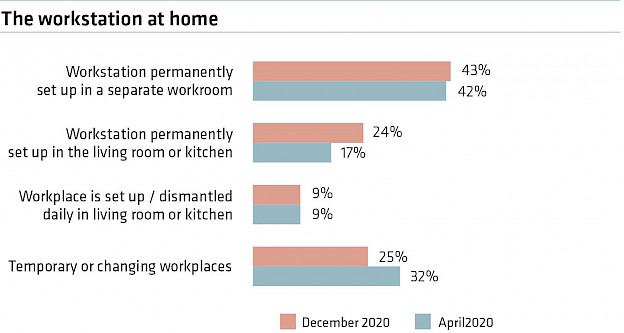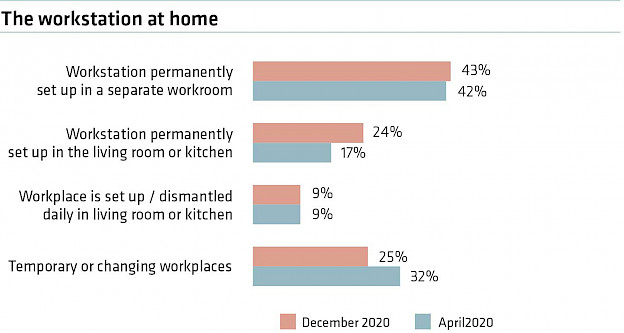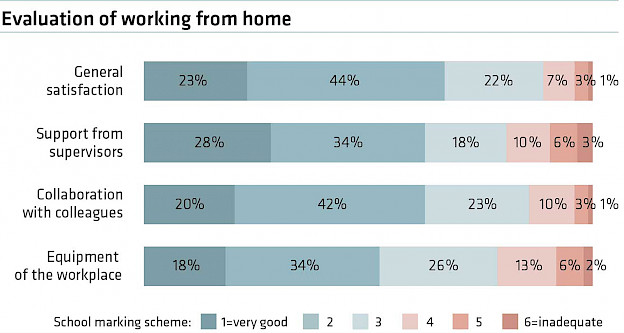Back in April 2020, during the first lockdown, the market and opinion research institute forsa had been commissioned by the IBA to survey approximately 1,000 employees concerning their experience of working from home. The result: overall, the quick transfer of work to employees working from home had functioned surprisingly well. However, in many cases this happened only because companies and employees turned out to be extremely creative and successfully improvised in areas where the necessary preconditions for regular work were missing. In December 2020, the IBA and forsa wanted to know what had changed in the interim and whether employees were able to count on support from their employers for equipping their home workstations or, alternatively, whether they had to depend on their own resources.
Working from home can mean many different things
In December 2020, 40% of dependent employees (13.5 million people) said they were working from home more often than they had done before the Covid-19 pandemic. At 42%, the result for April was at a similar level. There were clearer changes when the respondents were asked how much work they were doing from home. In December, only a third of those working from home were doing so full time, compared to 51% in April. As was shown in the course of the survey, the option of partly returning to work in the main office was used primarily by those employees who were unable to set up a fixed workstation at home.


Two thirds (67%) of those working from home had a permanent workstation set up by the time of the survey. In April only 59% of home office users had had a permanent workstation at home. Employees had obviously taken the initial steps toward professionalizing their working conditions at home during the period between the surveys.
Not optimal, but appreciated nonetheless
Most employees in Germany were still satisfied with working from home. The managers in question received exceptionally good marks. They were doing everything they could to support their employees who were working from home. This fact was rated just as positively as the employees’ cooperation with their colleagues. The equipment of the home workstations received considerably worse marks. Only half of the employees (52%) rated their equipment as “good” or “very good”. According to these results, by their own assessment about 6.5 million people were working from home under difficult or absolutely inadequate conditions. The employees who were working from home for less than two days a week were the most dissatisfied. Only 39% of them rated the equipment of their home workstations as good. The situation was not much better for the employees who worked from home three days a week and for the employees who were younger than 30. In these two groups, only 45% and 46% respectively were satisfied with the equipment of their workstations at home.


Nonetheless, in the course of 2020 many employees across all employee groups started to enjoy working from home. In April 21% of the respondents still hoped they would be able to return to full-time work in the main office. In December this was true of only 14% of the respondents. Thus most employees (73% or 9.4 million) were planning to work from home more often after the Covid-19 pandemic than before.
The respondents between the ages of 30 and 44 showed the greatest interest in working from home. And 76% of the employees in this group wanted to continue working from home as often as possible. At the same time, some of the survey results apply to all the employees in all employee groups. As a rule, the employees who were working full-time or almost full-time from home enjoyed doing so. 80% of these employees said they would be happy if they could work from home as often as possible on a permanent basis. The biggest group of employees who said they would like to return to the main office is part of the group who were working from home less than three days a week. One fifth (22%) of those who wanted to return to the main office hoped they would not have to work from home in the future.
The results of the survey indicate that the extent to which employees were working from home was in line with the wishes of the employees themselves. Wherever possible, a clear majority of employers seemed to be allowing their employees to decide for themselves how often they wanted to work from home.
Support only for technology
The fact that employees’ satisfaction with working from a home office increased during the summer of 2020 may be due not only to the development of a work routine but also to the improved equipment of their home workstations. According to the employees, they were mostly responsible for this improvement themselves. Except for their technical equipment, they received almost no support from their employers for furnishing their home workplaces.
Employers aged 45 and older invested somewhat more money in office furnishings than their younger colleagues. There were hardly any differences between the number of objects purchased by the employees who were working from home full-time in December 2020 and those who were working from home three days per week at most. By contrast, as could be expected, an individual employee’s attitude toward working from home had an impact on his or her willingness to purchase furniture and other work equipment. People who hope to be able to work from home more often in the future are more likely to be willing to make private investments of this kind.
Many of the employees who were working from home more often at the time of the surveys were planning to buy equipment for their home workplaces in 2021 as well. 25% of them wanted to buy office chairs, desks or similar furniture. However, according to their own assessments of the quality of their current equipment, these purchases would not cover their actual needs.
Most of the employees still did not have great expectations regarding their employers’ willingness to provide them with support for their new purchases. 81% of them assumed they would still have to pay for their planned purchases themselves in the future. 17% of the employees expected their employers to help them finance their planned new purchases.
INFORMATION ABOUT THE STUDY
forsa Politik- und Sozialforschung GmbH was commissioned by the IBA to conduct surveys from 1 to 8 December 2020 and from 21 to 28 April 2020 of dependent employees in Germany regarding their experiences with working from home. The respondents consisted of 1,002 and 1,000 individuals respectively between 18 and 65 years of age who were working from home more often during this period than before the Covid-19 pandemic. The respondents were selected according to a systematic random selection process. The forsa.omninet online panel was used for the surveys.
___
Title photography in this article: damircudic / iStock by Getty Images




